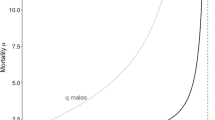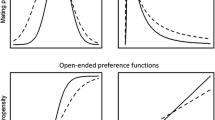Abstract
The strategy employed by a female to sample prospective mates determines the likelihood that a high-quality male is encountered in the search process. In general, the choosiness of females is expected to depend on the variability of quality amongst the males that are sampled. The sequential search strategy is a prominent model of search behavior that involves the use of a threshold criterion to evaluate encountered individuals. In this paper, we show that the stochastic dominance of one distribution of male quality over another at the second order is necessary and sufficient for the optimal threshold criterion to differ under two distributions of male quality when the cost to sample males is held constant and the mean quality of males under each of the distributions is identical. A difference of the variance of male quality between two distributions does not imply that one distribution stochastically dominates the other at the second order and, hence, should not, in general, be used to assess the relative variability of quality amongst prospective mates. The adjustment of the threshold criterion in response to experimental manipulations of the distribution of male quality has been inferred from induced differences of the duration of search or the number of males sampled in the search process. Here we show that such inferences are unjustified. In particular, the difference of the threshold criterion imposed by second-order stochastic dominance does not determine the distribution under which females are expected to sample a larger number of males in the search process.
Similar content being viewed by others
References
Andersson M (1994) Sexual selection. Princeton University Press, New Jersey
Brown L (1981) Patterns of female choice in mottled sculpins (Cottidae, Teleostei). Anim Behav 29: 375–382
Byers JA, Byers AA, Dunn SJ (2006) A dry summer diminishes mate search effort by pronghorn females: evidence for a significant cost of mate search. Ethology 112: 74–80
Draud MJ, Verga JN, Haley MP, Itzkowitz M (2008) Mate inspection patterns in the female beaugregory damselfish (Stegastes leucostictus). Acta Ethology 11: 6–15
Dombrovsky Y, Perrin N (1994) On adaptive search and optimal stopping in sequential mate choice. Am Nat 144: 355–361
Gibson RM, Langen T (1996) How do animals choose their mates?. Trends Ecol Evol 11: 468–470
Hanoch G, Levy H (1969) The efficiency analysis of choices involving risk. Rev Econ Stud 36: 335–346
Harder J, Russell WR (1969) Rules for ordering uncertain prospects. Am Econ Rev 59: 25–34
Hedrick AV, Dill LM (1993) Mate choice by female crickets is influenced by predation risk. Anim Behav 46: 193–196
Itzkowitz M, Draud MJ, Triefenbach F, Haley M (2001) The mating patterns of females when territorial differences among males are reduced: a test in the polygynous beaugregory damselfish. Behaviour 138: 691–708
Janetos AC (1980) Strategies of female mate choice: a theoretical analysis. Behav Ecol Sociobiol 7: 107–112
Jennions MD, Petrie M (1997) Variation in mate choice and mating preferences: a review of causes and consequences. Biol Rev Camb Philos Soc 7: 283–327
Johnson JB, Basolo AL (2003) Predator exposure alters female mate choice in the green swordtail. Behav Ecol 14: 619–625
Levy H (1992) Stochastic dominance and expected utility: survey and analysis. Manag Sci 38: 555–593
Levy H (2006) Stochastic dominance: investment decision making under uncertainty, 2nd edn. Springer, New York
Luttbeg B (1996) A comparative Bayes tactic for mate assessment and choice. Behav Ecol 7: 451–460
Luttbeg B (2002) Assessing the robustness and optimality of alternative decision rules with varying assumptions. Anim Behav 63: 805–814
Milinski M, Bakker TCM (1992) Costs influence sequential mate choice in sticklebacks Gasterosteus aculeatus. Proc R Soc Lond B 250: 229–233
Moore AJ, Moore PJ (1988) Female strategy during mate choice: threshold assessment. Evolution 42: 323–331
Real LA (1990) Search theory and mate choice. I. Models of single-sex discrimination. Am Nat 136: 376–404
Real LA (1991) Search theory and mate choice. II. Mutual interaction, assortative mating, and equilibrium variation in male and female fitness. Am Nat 138: 901–917
Reid ML, Stamps JA (1997) Female mate choice tactics in a resource-based mating system: field tests of alternative models. Am Nat 150: 98–121
Rosenqvist G, Houde A (1997) Prior exposure to male phenotypes influences mate choice in the guppy, Poecilia reticulata. Behav Ecol 8: 194–198
Rothschild M, Stiglitz JE (1970) Increasing risk. I. A definition. J Econ Theory 2: 225–243
Wagner WE Jr, Smeds MR, Wiegmann DD (2001) Experience affects female response to male song in the variable field cricket. Ethology 107: 769–776
Whitmore GA (1970) Third degree stochastic dominance. Am Econ Rev 60: 457–459
Wiegmann DD, Angeloni LM (2007) Mate choice and uncertainty in the decision process. J Theor Biol 249: 654–666
Wiegmann DD, Morris M (2005) Search behavior and mate choice. Rec Adv Exp Theor Biol 1: 201–216
Wiegmann DD, Real LA, Capone TA, Ellner S (1996) Some distinguishing features of models of search behavior and mate choice. Am Nat 147: 188–204
Wiegmann DD, Mukhopadhyay K (1998) The fixed sample search rule and use of an indicator character to evaluate mate quality. J Theor Biol 193: 709–715
Wiegmann DD, Mukhopadhyay K, Real LA (1999) Sequential search and the influence of male quality on female mating decisions. J Math Biol 39: 193–216
Wiegmann DD, Seubert SM, Wade GA (2010a) Mate choice and optimal search behavior: fitness returns under the fixed sample and sequential search strategies. J Theor Biol 262: 596–600
Wiegmann DD, Weinersmith KL, Seubert SM (2010b) Multi-attribute mate choice decisions and uncertainty in the decision process: a generalized sequential search strategy. J Math Biol 60: 543–572
Wittenberger JF (1883) Tactics of mate choice. In: Bateson P (ed) Mate choice. Cambridge University Press, New York, pp 435–447
Author information
Authors and Affiliations
Corresponding author
Rights and permissions
About this article
Cite this article
Seubert, S.M., Wade, G.A. & Wiegmann, D.D. The variability of male quality and female mate choice decisions: second-order stochastic dominance and the behavior of searchers under a sequential search strategy. J. Math. Biol. 63, 1121–1138 (2011). https://doi.org/10.1007/s00285-010-0399-8
Received:
Revised:
Published:
Issue Date:
DOI: https://doi.org/10.1007/s00285-010-0399-8




